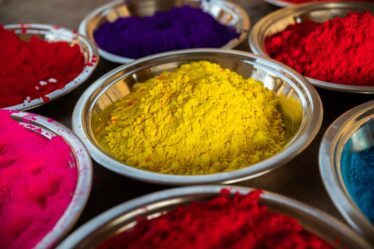
Korean red pepper flakes, also known as gochugaru, are a staple ingredient in Korean cuisine. They have a rich history and origin that dates back centuries. Gochugaru is made from sun-dried red chili peppers that are ground into flakes. The peppers used are typically a variety called Korean red chili, which is known for its vibrant red color and medium heat level.
In Korean cuisine, gochugaru is used in a wide range of dishes, including kimchi, stews, soups, and marinades. It adds a unique flavor and heat to these dishes, giving them a distinct Korean taste. The flavor profile of gochugaru is slightly sweet and smoky, with a moderate level of heat. It is not as spicy as some other chili peppers, making it suitable for those who prefer milder heat levels.
Key Takeaways
- Korean red pepper flakes are a popular spice used in many Korean dishes.
- Substitutes for Korean red pepper flakes may be necessary due to availability or personal preference.
- Spices play an important role in enhancing the flavor of dishes.
- When choosing a substitute for Korean red pepper flakes, consider the heat level and flavor profile.
- Top 5 substitutes for Korean red pepper flakes include cayenne pepper, paprika, red pepper flakes, gochujang, and chili powder.
Why Look for a Substitute for Korean Red Pepper Flakes?
While gochugaru is widely available in Korea and in many international markets, it may be harder to find in certain regions. This can be frustrating for those who want to recreate authentic Korean dishes but don’t have access to gochugaru. Additionally, some people may have allergies or dietary restrictions that prevent them from using gochugaru. In these cases, finding a suitable substitute becomes necessary.
Personal preference is another reason why someone might look for a substitute for gochugaru. Not everyone enjoys the flavor profile or heat level of gochugaru, and they may prefer to use different spices or chili peppers in their cooking.
The Importance of Spices in Cooking
Spices play a crucial role in enhancing the flavor and aroma of dishes. They add depth and complexity to food, making it more enjoyable to eat. Different cuisines around the world rely on spices to create their signature flavors.
In Korean cuisine, gochugaru is just one of many spices used to create the unique taste of Korean dishes. Other common spices include garlic, ginger, soy sauce, and sesame oil. These spices work together to create a harmonious balance of flavors.
Using spices in cooking also has health benefits. Many spices have antioxidant and anti-inflammatory properties, which can help boost the immune system and reduce the risk of chronic diseases. Spices also add flavor without adding extra calories or sodium, making them a healthy choice for seasoning food.
Factors to Consider When Choosing a Substitute for Korean Red Pepper Flakes
| Factors to Consider | Description |
|---|---|
| Heat Level | Choose a substitute that matches the heat level of Korean red pepper flakes. |
| Flavor Profile | Consider the flavor profile of the substitute and how it will affect the overall taste of the dish. |
| Availability | Choose a substitute that is readily available in your area or can be easily ordered online. |
| Cost | Consider the cost of the substitute and how it fits into your budget. |
| Texture | Consider the texture of the substitute and how it will affect the texture of the dish. |
When looking for a substitute for gochugaru, there are several factors to consider. The flavor profile and heat level of the substitute should be similar to gochugaru to ensure that it complements the other ingredients in the dish. The texture and appearance of the substitute should also be taken into account, as it can affect the overall presentation of the dish.
Availability and cost are important considerations as well. Some substitutes may be more readily available or affordable than others, depending on where you live. It’s also important to consider the compatibility of the substitute with the dish being prepared. Certain substitutes may work better in certain dishes than others.
Top 5 Substitutes for Korean Red Pepper Flakes
1. Cayenne pepper: Cayenne pepper is a popular substitute for gochugaru because it has a similar heat level and flavor profile. It is made from ground dried cayenne chili peppers and has a bright red color. Cayenne pepper is hotter than gochugaru, so you may need to use less of it in your recipes.
2. Crushed red pepper flakes: Crushed red pepper flakes are another common substitute for gochugaru. They are made from dried chili peppers that have been crushed into small flakes. Crushed red pepper flakes have a similar heat level to gochugaru, but they may have a slightly different flavor profile.
3. Aleppo pepper: Aleppo pepper is a mild chili pepper that is commonly used in Middle Eastern and Mediterranean cuisines. It has a fruity and slightly sweet flavor, with a moderate level of heat. Aleppo pepper can be used as a substitute for gochugaru in dishes that require a milder heat level.
4. Paprika: Paprika is made from ground dried peppers and has a mild, sweet flavor. It is available in different varieties, including sweet, smoked, and hot. Sweet paprika can be used as a substitute for gochugaru if you prefer a milder heat level.
5. Gochujang: Gochujang is a Korean chili paste that is made from fermented soybeans, rice, and red chili peppers. It has a thick, sticky texture and a complex flavor that is both sweet and spicy. Gochujang can be used as a substitute for gochugaru in certain dishes, but it will add a different flavor profile to the dish.
How to Use Substitutes for Korean Red Pepper Flakes in Your Cooking

When using substitutes for gochugaru in Korean dishes, it’s important to consider the flavor profile and heat level of the substitute. You may need to adjust the amount of substitute used to achieve the desired taste. It’s also important to note that the texture and appearance of the dish may be slightly different when using a substitute.
In addition to using substitutes in Korean dishes, you can also experiment with them in other cuisines. For example, cayenne pepper can be used to add heat to Mexican or Indian dishes, while paprika can be used to add color and flavor to Hungarian or Spanish dishes.
There are many recipes available that feature substitutes for gochugaru. Some popular options include spicy stir-fried tofu with cayenne pepper, spicy shrimp pasta with crushed red pepper flakes, and roasted vegetables with Aleppo pepper.
Tips for Adjusting the Heat Level in Your Dishes
If you find that a dish is too spicy, there are several ways to decrease the heat level. Adding dairy products, such as yogurt or sour cream, can help to cool down the spiciness. Sweetening the dish with sugar or honey can also help to balance out the heat.
On the other hand, if you want to increase the heat level of a dish, you can add more of the substitute or use a hotter substitute. You can also add fresh chili peppers, such as jalapenos or Thai chilies, to increase the spiciness.
It’s important to note that other ingredients in the dish can also affect the heat level. For example, using more acidic ingredients, such as vinegar or citrus juice, can enhance the perception of heat. Adding fats, such as oil or butter, can help to mellow out the spiciness.
How to Store and Preserve Your Substitutes for Korean Red Pepper Flakes
To ensure that your substitutes for gochugaru stay fresh and flavorful, it’s important to store them properly. Spices should be stored in a cool, dry place away from direct sunlight and moisture. They should be kept in airtight containers to prevent moisture and air from getting in.
To extend the shelf life of your substitutes, it’s best to buy them in small quantities and use them within a few months. Over time, spices can lose their flavor and potency, so it’s important to regularly check their freshness.
To keep your spices fresh and flavorful, avoid storing them near heat sources, such as stoves or ovens. It’s also a good idea to label your spices with the date of purchase so that you can keep track of their freshness.
Frequently Asked Questions About Substitutes for Korean Red Pepper Flakes
1. Can I use chili powder as a substitute?
Chili powder is not recommended as a substitute for gochugaru because it typically contains other spices, such as cumin and garlic powder, which can alter the flavor profile of the dish. Additionally, chili powder may have a different heat level than gochugaru.
2. What is the difference between cayenne pepper and crushed red pepper flakes?
Cayenne pepper is made from ground dried cayenne chili peppers, while crushed red pepper flakes are made from dried chili peppers that have been crushed into small flakes. Cayenne pepper is hotter than crushed red pepper flakes, so you may need to use less of it in your recipes.
3. How do I know which substitute to use in a particular dish?
The best substitute for gochugaru will depend on the specific dish you are making and your personal taste preferences. It’s a good idea to start with a small amount of the substitute and adjust to taste. You can also consult recipes or ask for recommendations from experienced cooks.
Experiment with Different Substitutes to Enhance Your Cooking.
In conclusion, Korean red pepper flakes, or gochugaru, are a versatile spice that adds flavor and heat to Korean dishes. However, if gochugaru is not available or suitable for your needs, there are several substitutes that you can use. Cayenne pepper, crushed red pepper flakes, Aleppo pepper, paprika, and gochujang are all viable options.
When using substitutes, it’s important to consider the flavor profile and heat level of the substitute, as well as its compatibility with the dish being prepared. You can experiment with different substitutes in both Korean and other cuisines to create unique and flavorful dishes.
Remember to store your substitutes properly to keep them fresh and flavorful. And don’t be afraid to adjust the heat level of your dishes to suit your taste preferences. With a little experimentation and creativity, you can enhance your cooking and discover new flavors.
If you’re looking to add a unique and vibrant flavor to your dishes, why not try exploring the world of tropical fruits? Mamey Sapote is one such fruit that offers a delightful adventure for your taste buds. Learn more about this exotic fruit and how it can elevate your culinary creations in this fascinating article from Flavorful Sips: Mamey Sapote: A Tropical Flavor Adventure. Discover the astounding flavors of apples in a whole new light with this captivating article from Flavorful Sips: Astounding Flavors of Apples Bar. And if you’re in search of a Korean citrus delight, look no further than Yuja Hwachae. Uncover the secrets of this refreshing and tangy fruit in this enlightening article from Flavorful Sips: Discovering Yuja Hwachae: The Korean Citrus Delight.



